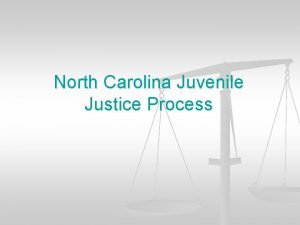POLI 203 North Carolina Reforms North Carolina was





















- Slides: 21

POLI 203, North Carolina Reforms • North Carolina was a leader in various criminal justice reforms • Lots of exonerations here, or rather many of them got a lot of media coverage and concern by public officials. • So, while we were not a leader in wrongful convictions, we have become a leader in reform. These have certainly contributed to the dramatic drop in use of the death penalty described the other day. • April 15, 2020 Baumgartner, POLI 203, Spring 2020 1

Announcements and catch-up • Feedback on Quiz # 4. • Overall: Average grade was 7. • Slightly worse than previous quizzes. Here are hints with regards to particular questions where many of you missed the correct answer. • Q 2: when can you set a death date: after direct appeals • Q 3: when can you get a stay: it has to “benefit the public” • Q 5: Curtis Flowers never falsely confessed… • Q 7: what predicts the number of death sentences. Not politics; but the tone of news coverage. Baumgartner, POLI 203, Spring 2020 2

A crisis of confidence, a wave of reforms • Lots of attention to exonerations and errors • Financial cost • Long delays from death sentence to execution • High rates of reversal in death sentences • (Note: Any reader of Deadly Justice would know that none of these trends were peculiar to North Carolina. In fact, they have played out in similar manners in many states, which is why we see such a decline in death sentences and executions…) Baumgartner, POLI 203, Spring 2020 3

Exonerations • From 1989 to 2020, the National Registry of Exonerations shows 64 cases from North Carolina: Go to National Registry Click on summary view Click on the button at the top that says “State” and select only NC You can see the 64 cases Sort by year and you can see they begin in 1989, with convictions going back to 1988. • Lots of cases from 1997 through 2008: almost 20 cases… • • • Baumgartner, POLI 203, Spring 2020 4

Media coverage to NC exoneration cases Willie Grimes not the star; Darryl Hunt got a lot of attention, however This attention came in the period from 2004 through 2018 especially… Baumgartner, POLI 203, Spring 2020 5

We saw on Monday • Delays: Among the 42 inmates ever executed, an average delay of 11 years. Of course, as you know from the national study, this number will only increase. And if they were to re-start executions today, the average inmate on death row has already been there for 20 years, with one already having served 34 years and many having served 25 years or longer. • Reversals: About 70 percent of cases are reversed. Again, similar to national averages. • Two responses: this system is broken, must be abandoned. This system is broken, must be streamlined, speeded up so we can get back to executing. Both are occurring as we speak. • But the innocence and the cost arguments have struck a cord with Conservative elected officials and others in a way that due process rights for convicted criminals never has or likely will. Baumgartner, POLI 203, Spring 2020 6

Other smaller issues, and the over all decline continues. • 2006 Cost study by Phil Cook at Duke: Retaining the death penalty as a legal option costs the state about $11, 000 per year. • 2010 Raleigh N&O analysis of SBI forensic evidence scandals • Greg Taylor case; note that 3 of the 200 potentially innocent people affected by the SBI testimony / analysis scandal have been executed! • So there have been really strong reasons for declining enthusiasm. • Result: advocates for reduction push very hard. Enthusiasts for continuing use are not really pushing very hard. Juries are not sentencing, and many DA’s are not even asking for death. Baumgartner, POLI 203, Spring 2020 7

Results of this crisis of confidence: Reforms • Note that many of these reforms may have the effect of exacerbating the very issues they are designed to address. • Protecting claims of innocence can have the effect of increasing reversal rates, increasing costs, and increasing delays. • So, no matter the intentions, which have mostly been driven by concerns about innocence and errors, the reforms have put a serious squeeze on the flow of capital prosecutions and death sentences. And, of course, they have completely stopped executions. Baumgartner, POLI 203, Spring 2020 8

Sentencing Reform, 1993 • The current sentencing system dates from 1993. It was not really a death penalty reform. But it lowered penalties for some crimes, and increased them for others: “Habitual felons” and high-level offenders, particularly with many prior points, could get LWOP. • Before then, as you recall from the Willie Grimes example, the punishment of Life in prison meant eligibility for parole after 20 years. • After 1993, the punishment of LWOP was available, and widely applied for second degree homicide. • This reduced the benefit in a plea-bargain of moving from first- to seconddegree homicide. The person would still get LWOP. • This by itself could have reduced quite a lot the incentive to seek death. • So, ironically: A “harsh on crime” reform may have reduced support for the death penalty. It made the default, non-death, punishment harsher. Baumgartner, POLI 203, Spring 2020 9

Post-conviction discovery, 1996 • DA’s must allow access to the full range of evidence for postconviction review by the defense attorney • (That is, comply with Brady! Brady v. Maryland dates to 1963, btw. ) Baumgartner, POLI 203, Spring 2020 10

Indigent Defense Services Act of 2000 • Effective 7/1/2001 • Why this matters: Before this time, the judge in the case would appoint an attorney to represent the defendant if, like most capital defendants, they could not afford a private attorney. • Sometimes, they appointed people like Ken Rose, people who are specialists in the peculiarities of capital procedure, which is very different than other kinds of criminal law… • However, especially in small counties with few cases, and few attorneys, they would not appoint a specialist. In fact, the law only required that the attorney: • Be licensed to practice law • Accept the payment and terms, which could be a flat fee of $5, 000 Baumgartner, POLI 203, Spring 2020 11

IDS, Center for Death Penalty Litigation • IDS is a state agency • It has an annual budget, coordinates all public defender offices. • CDPL is a non-profit • Does trainings • Certifies attorneys to be capital-specialists • Some are on staff, others are private attorneys around the state • These attorneys, some on staff at CDPL, but others affiliated with them, get appointed by IDS to represent capital defendants. • The differences • Defense attorney appeals to IDS, not to the judge in the case, for funds for things like investigations and experts. More even playing field compared to the DA’s, who also have their own budget independent from the judge. • Only well qualified people end up defending capital defendants. And 2 lawyers, not just one. • So this was a huge change. It came at the exact same time as Prosecutorial discretion was allowed, July 1, 2001. Baumgartner, POLI 203, Spring 2020 12

Prosecutor discretion to seek the death penalty or not (2001) • Effective 7/1/2001 • Last state in the nation to enact this reform. • Any first degree murder had to be prosecuted capitally. • Note that the DA decides whether a homicide is first degree (premeditated), second degree (heat of passion), manslaughter (either recklessly or inadvertently causing death, as in a car crash or a construction / work accident), or not a crime at all (self-defense). • This reform also allowed for plea-bargaining, which was huge. Baumgartner, POLI 203, Spring 2020 13

Immediate results from the 2001 reform. Each dot is a county. Some higher, some lower, but all showed a big decline in percent of homicides charged capitally. Baumgartner, POLI 203, Spring 2020 14

Other major reforms • No death penalty for individuals with mental incapacity (2002) • Pre-dates Atkins v. Virginia (2005) and was cited as part of the “evolving standards” trend that justified the prohibition of executing those with low IQ. • Pre-trial discovery, 2004 • Compliance with Brady must be before trial, not only after the conviction. • Innocence Inquiry Commission, 2006 • Begins work in 2007, some death penalty cases, definitely a sign of concern about accuracy Baumgartner, POLI 203, Spring 2020 15

NC Eyewitness Identification Reform Act of 2007 • See copy of the law and implementation materials on the class website. • Best practices include: • Independent administrator (the person who does the line-up has no idea who the suspect is; is not involved in the investigation). Alternative: “folder method” where there are manilla folders, marked with numbers. • Photos must be contemporaneous to the crime, and fillers must “generally resemble” the eyewitness description • Instructions to the witness: “person may or may not be here…”; “as important to exclude” as it is to identify; “investigation will continue” no matter what… • Document the degree of confidence the witness has. Baumgartner, POLI 203, Spring 2020 16

Major reforms affecting the death penalty / percent of current inmates NOT subject to this reform • 1994: LWOP created as an alternative punishment / 19 • 1996: Post-Conviction Discovery / 42 • 2001: Indigent Defense Services / 71 • 2001: Prosecutorial discretion to seek the death penalty or not / 71 • 2001: Post-conviction DNA testing / 73 • 2004: Pre-trial open file discovery / 82 • 2008: Eyewitness ID reform / 90 • 2011: Forensic Science Reforms / 95 (Note: percentages are based on date of death sentence. None of the reforms was retroactive, so inmates sentenced before those dates did not benefit from these reforms. ) Baumgartner, POLI 203, Spring 2020 17

These reforms are associated with a dramatic decline since 1993 in the number of sentences. Baumgartner, POLI 203, Spring 2020 18

Current death row inmates: About 2/3 were already on death row before the 2001 reforms. Baumgartner, POLI 203, Spring 2020 19

Net results: low rates per 100 homicides, and almost no death sentences in recent years Death sentence rate per 100 homicides Number of death sentences in NC Baumgartner, POLI 203, Spring 2020 20

That’s it for today • Next week, I’ll be answering your questions and reviewing. • Please feel free to email if you have questions you want me to cover. • Don’t forget to take the quiz this week, starting Wed at 11. • Good luck and stay healthy. • BTW, I miss seeing all of you! Baumgartner, POLI 203, Spring 2020 21
 Virginia, maryland, north carolina, south carolina, georgia
Virginia, maryland, north carolina, south carolina, georgia Georgia, south carolina, north carolina, virginia, maryland
Georgia, south carolina, north carolina, virginia, maryland What is this image
What is this image Maryland, virginia, north carolina, south carolina, georgia
Maryland, virginia, north carolina, south carolina, georgia Nciha
Nciha Local government investment pool services north carolilna
Local government investment pool services north carolilna Face jugs north carolina
Face jugs north carolina Residency determination service
Residency determination service Family support network of north carolina
Family support network of north carolina North carolina victim assistance network
North carolina victim assistance network University of north carolina chapel hill computer science
University of north carolina chapel hill computer science Undisciplined juvenile petition nc
Undisciplined juvenile petition nc North carolina medical examiner toxicology
North carolina medical examiner toxicology South carolina state shell
South carolina state shell Chapter 13: north carolina state government
Chapter 13: north carolina state government North carolina geographic regions
North carolina geographic regions North carolina relative location
North carolina relative location Mcnc north carolina
Mcnc north carolina North carolina board of professional counselors
North carolina board of professional counselors Why was north carolina founded
Why was north carolina founded Craiglist escorts lykens pa
Craiglist escorts lykens pa Sc landforms
Sc landforms








































